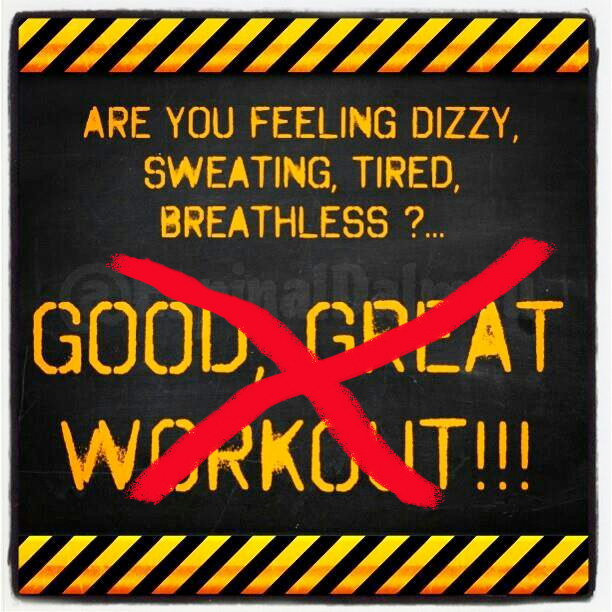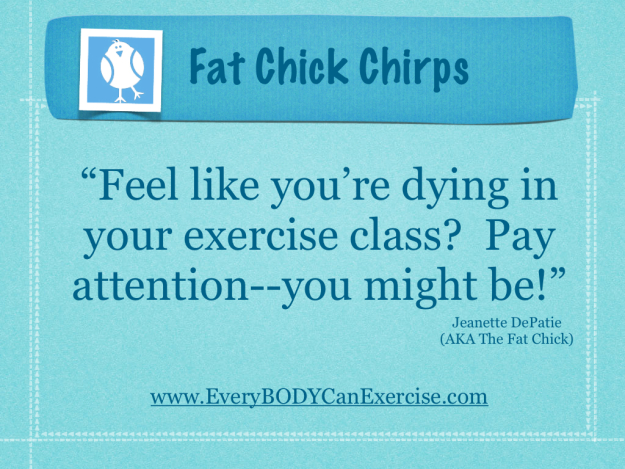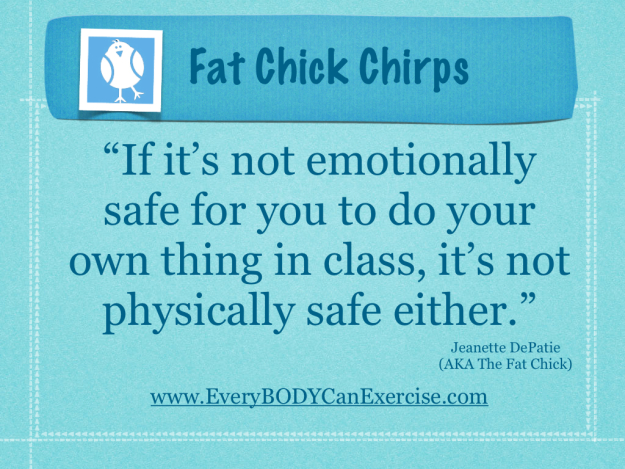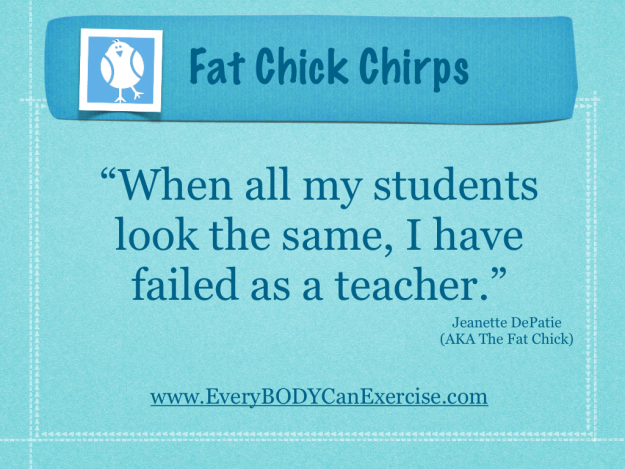Join the Club!
Fill out the contact form below and we’ll get you a free exercise tracker!
My dear friend Ragen Chastain mentioned on Facebook that she had gone to an enjoyable Zumba class the night before, but was dismayed the next day when she checked out the Zumba studio’s facebook page. Apparently they posted an image stating: “Are You Feeling Dizzy, Sweating, Tired, Breathless? … Good, Great Workout!!!” I’ve posted my modified version below:

Okay, so let’s get started on how wrong this is. Not a little bit wrong. Not even a medium amount of wrong. A Carl Sagan, galaxy-filled COSMOS of wrong. This is not inspiring. This is not cool. This is irresponsible and dangerous.
This sign to me represents a culture where we learn to ignore the signals our bodies send as we work out. This is about a culture of masochism, where the more pain and agony you endure during a workout, the closer you bring your body to the edge of absolute destruction during a workout, the better. And as an exercise teacher this makes me absolutely crazy. Because, the messages you receive from your body are the most important line of defense, the most important tool you could possibly use to keep yourself safe as you work out.
I don’t want to scare you. Most people work out safely most of the time. But there ARE risks associated with exercise. If you have an underlying heart condition, you are more likely to face a heart attack while working out than you are in your bed. If you have issues with low blood sugar, they are more likely to surface when you are strenuously exercising. If you are at risk for stroke, this is more likely to be an issue when you are taking an exercise class than when you are reading a book. Again, the vast majority of the time, the vast majority of people exercise safely. But when things do go wrong, they are often preceded by warning signs like excess sweating and severe exhaustion and shortness of breath and dizziness. These are not indicators of a great workout. These are indicators of a problem. Exercisers ignore these symptoms at their own peril.
 As a fitness instructor, I remind my students over and over and over again that they must learn to listen to their own bodies. I do everything I can to watch for visible warning signs and symptoms among my students. But the first and most important line of defense is for them to recognize warning signs in themselves. They will probably feel dizzy long before I sense that they look dizzy. Therefore, it’s my job to create an environment where they feel safe caring for themselves. Every time a new person comes to my class we have a ritual. I ask my long standing students to help me. I shout out, “What happens if you get the choreography wrong?” My students reply, “Nothing! It doesn’t matter!” I shout out, “What if it hurts when I do this?” They answer, “Stop doing it!” I ask, “Who’s class is this?” My students answer, “MY Class!”
As a fitness instructor, I remind my students over and over and over again that they must learn to listen to their own bodies. I do everything I can to watch for visible warning signs and symptoms among my students. But the first and most important line of defense is for them to recognize warning signs in themselves. They will probably feel dizzy long before I sense that they look dizzy. Therefore, it’s my job to create an environment where they feel safe caring for themselves. Every time a new person comes to my class we have a ritual. I ask my long standing students to help me. I shout out, “What happens if you get the choreography wrong?” My students reply, “Nothing! It doesn’t matter!” I shout out, “What if it hurts when I do this?” They answer, “Stop doing it!” I ask, “Who’s class is this?” My students answer, “MY Class!”
I then remind the students that it is okay for them to modify any move that isn’t working for them and to ask for help if they need it. I give them a “safety move” like gently marching in place they should feel free to do when they get stuck. And I remind them that they can feel free to use any of the sturdy chairs located throughout the room to do a movement or even just rest in a chair whenever they feel they need to. I work VERY hard to create an exercise space where my students feel emotionally safe doing whatever they need to do to take care of themselves.
 Although creating this emotionally safe space helps my students feel good about themselves, I don’t do it for that reason alone. I do it to keep them physically safe as well. A class culture based on “no pain no gain”, where students are discouraged to tough it out and not take care of themselves is risky and can be downright dangerous. Teaching students to ignore the messages their bodies are sending is the absolute LAST thing we should do.
Although creating this emotionally safe space helps my students feel good about themselves, I don’t do it for that reason alone. I do it to keep them physically safe as well. A class culture based on “no pain no gain”, where students are discouraged to tough it out and not take care of themselves is risky and can be downright dangerous. Teaching students to ignore the messages their bodies are sending is the absolute LAST thing we should do.
 I want students in my class to look different from one another. A class where students are modifying moves and resting from time to time and approaching the movement in different ways is good and healthy. It means the class is challenging enough for the more advanced students to get something out of it while being a safe place for less advanced students to increase strength, stamina and agility–gently and gradually. It means everybody is working at their own pace and having a good time. Which is as it should be. When students come to me and tell me that they are in pain, that is a signal for me to make some changes to my class. How can I teach that move differently? How can I make sure everybody is working at their own pace? How can I remind the students about body alignment and positioning to make them less likely to get hurt? How can I make my class better?
I want students in my class to look different from one another. A class where students are modifying moves and resting from time to time and approaching the movement in different ways is good and healthy. It means the class is challenging enough for the more advanced students to get something out of it while being a safe place for less advanced students to increase strength, stamina and agility–gently and gradually. It means everybody is working at their own pace and having a good time. Which is as it should be. When students come to me and tell me that they are in pain, that is a signal for me to make some changes to my class. How can I teach that move differently? How can I make sure everybody is working at their own pace? How can I remind the students about body alignment and positioning to make them less likely to get hurt? How can I make my class better?
As I have stated before, this is why it is often best to just watch the first time you encounter a new class. Don’t wait until after you are in the middle of a testosterone-fueled judgement festival to determine that a class might not be for you. Don’t put yourself in a situation where you might let embarrassment push you into hurting yourself–perhaps permanently. Watch and learn. If your gut tells you that this is a judgement zone that is not emotionally safe–then walk away. If the class isn’t emotionally safe for you, it’s not safe. Period.
We tell people that exercise should hurt and feel awful. We tell them that listening to their own bodies is wrong and that they should push it until they puke. We tell them that getting injured is a sign of their own weakness and that real exercisers don’t let sprains or stress fractures stop them. THEN we wonder why half the world doesn’t exercise.
Fugeddabout it!
Find a way that your body loves to move and do that. When it stops feeling good, and it starts to hurt, then stop. Forever and ever, Amen.
Love,
Jeanette DePatie (AKA The Fat Chick)
9 Comments. Leave new
I wish i was near enough to come to one of your classes : )
I was thinking the same thing! 🙂
Now I know why I’ve never enjoyed exercise that “felt like exercise,” because it’s not actually supposed to feel that way. I enjoy walking, hula hooping, dancing… high impact stuff hurts for me, and I’m just not a masochist.
You wrote: where students are discouraged to tough it out and not take care of themselves is risky and can be downright dangerous.
I think you might mean “encouraged”
I do like to push it a bit when I work out sometimes, but there is a big, big difference between needing to catch your breath a little on your cooldown and being UNABLE to catch your breath. And I’d never chalk dizziness (or puking, for crying out loud) up to a good workout. There’s also a difference between seeing if a minor twinge in the knee works itself out on the bicycle when you gear down, and a pain that starts growing worse. These are danger signals. It is completely irresponsible to promote a culture where your body’s real needs are seen as weaknesses that you need to push through.
Reblogged this on Stepping into yourself and commented:
No pain, no gain? Wrong. So much fitspiration is off putting and potentially harmfil
Reblogged this on stitchgnomercy and commented:
I’ve been TAing for a sociology of sport & exercise class for our undergrad Kinesiology majors….and I have to keep telling them how our current culture of “no pain, no gain” is a cultural construct that is not useful for encouraging physical activity (and maintaining it as a lifelong pursuit!)
[…] This stupid thing supports the idea of no pain, no gain. This idea MUST DIE as it convinces people to work out in a way that is unsustainable, causes injuries and prevents them […]
Reblogged this on Sacred Discomfort and commented:
YES, YES, YES!!!! So much yes! Part of the reason I loved yoga was that it was, to me, the perfect way to bring together all kinds of people of all different abilities in one space. It was a way for ALL of them to gain confidence, strength, stamina, wisdom, connection to themselves, and to push through the bullshit messages of the media about what makes a ‘perfect’ body.
I always said, ‘If it hurts, don’t do it!’ SO agree with this post!